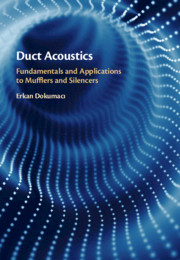Book contents
- Duct Acoustics
- Duct Acoustics
- Copyright page
- Dedication
- Contents
- Preface
- 1 Some Preliminaries
- 2 Introduction to Acoustic Block Diagrams
- 3 Transmission of Low-Frequency Sound Waves in Ducts
- 4 Transmission of One-Dimensional Waves in Coupled Ducts
- 5 Resonators, Expansion Chambers and Silencers
- 6 Multi-Modal Sound Propagation in Ducts
- 7 Transmission of Wave Modes in Coupled Ducts
- 8 Effects of Viscosity and Thermal Conductivity
- 9 Reflection and Radiation at Open Duct Terminations
- 10 Modeling of Ducted Acoustic Sources
- 11 Radiated Sound Pressure Prediction
- 12 Measurement Methods
- 13 System Search and Optimization
- Book part
- Index
- References
7 - Transmission of Wave Modes in Coupled Ducts
Published online by Cambridge University Press: 11 May 2021
- Duct Acoustics
- Duct Acoustics
- Copyright page
- Dedication
- Contents
- Preface
- 1 Some Preliminaries
- 2 Introduction to Acoustic Block Diagrams
- 3 Transmission of Low-Frequency Sound Waves in Ducts
- 4 Transmission of One-Dimensional Waves in Coupled Ducts
- 5 Resonators, Expansion Chambers and Silencers
- 6 Multi-Modal Sound Propagation in Ducts
- 7 Transmission of Wave Modes in Coupled Ducts
- 8 Effects of Viscosity and Thermal Conductivity
- 9 Reflection and Radiation at Open Duct Terminations
- 10 Modeling of Ducted Acoustic Sources
- 11 Radiated Sound Pressure Prediction
- 12 Measurement Methods
- 13 System Search and Optimization
- Book part
- Index
- References
Summary
Chapter 7 describes modal acoustic models of several coupled duct configurations. The acoustic models described in this chapter extend the one-dimensional area change, junction and perforate elements described in Chapters 3 to three dimensions.
- Type
- Chapter
- Information
- Duct AcousticsFundamentals and Applications to Mufflers and Silencers, pp. 326 - 368Publisher: Cambridge University PressPrint publication year: 2021

